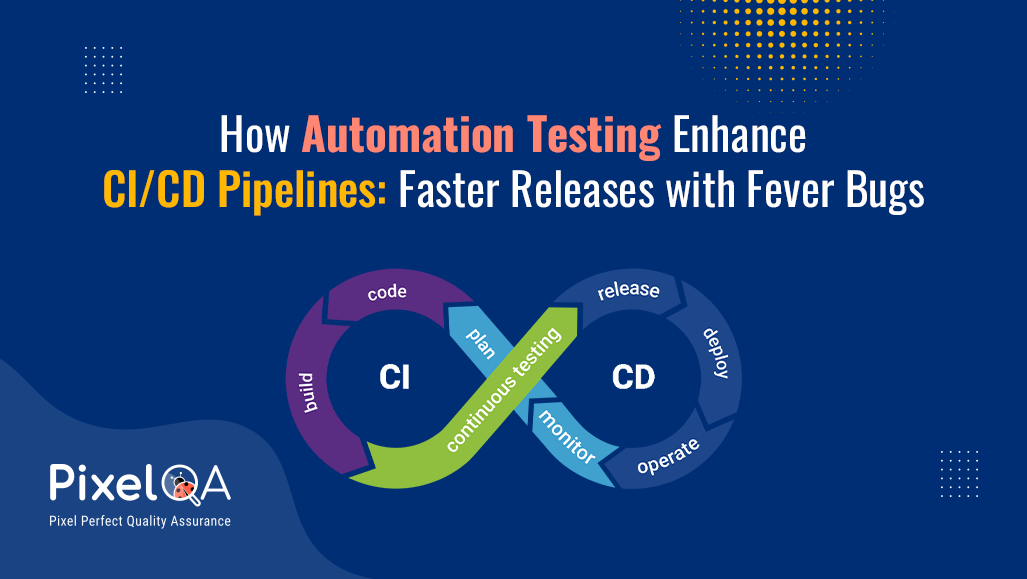
Section No.
- 1 - Introduction
- 2 - Understanding the CI/CD Pipeline
- 3 - The Role of Automation Testing in CI/CD
- 4 - Key Benefits of Automation Testing
- 5 - Tools That Bridge Automation and CI/CD
- 6 - Types of Tests to Automate
- 7 - Real-World Impact
- 8 - Select the Right Partner
- 9 - Conclusion
Introduction
Automation Testing is at the core of any CI/CD pipeline. This is because the whole concept of CI/CD revolves around “build fast, test fast, fail fast.” Tests must be run as fast as possible so that the feedback reaches the developer early. This enables the early detection of bugs.
Before look goes for automation testing services, it is important to understand what the CI/CD needs are:
Continuous Integration (CI)- Developers push code daily to a shared repository. Automated builds and tests are triggered to verify the changes do not break the application.
Continuous Delivery (CD)- Code that passes in CI moves to staging environments for further testing and is prepared for production deployment.
CI/CD aims to improve the software quality, make software development faster, more agile and faster releases. Boost confidence in software deployment to production.
Understanding the CI/CD Pipeline
In today’s fast-paced software world, delivering quality applications quickly is crucial—and that’s where the CI/CD pipeline comes in. CI/CD stands for Continuous Integration and Continuous Delivery, a development practice that helps teams integrate code frequently, test automatically, and deploy quickly. When developers push new code to a shared repository, CI tools automatically build and test the code to catch issues early. This not only ensures that the software works as expected, but also reduces the chance of bugs slipping into production.
At PixelQA, we help businesses build and optimize CI/CD pipelines that enhance efficiency and reliability. By combining automation with robust testing strategies, our team ensures that every stage—from code integration to deployment—is seamless and error-free. A well-structured CI/CD pipeline doesn’t just save time—it empowers teams to innovate faster, respond to market changes more efficiently, and deliver high-quality software that users can trust.
Role of automation test in CI/CD
Automation tests include special equipment to execute structured tests on a software application, before it is released into production. When the CI/CD is integrated into the pipeline, these tests are automatically coded. When the code is committed, it is verified that new changes do not break the available features/existing functionality.
Major benefits of automation test in CI/CD
1. Increases efficiency and productivity
Automatic tests increase efficiency and productivity to run faster and more often than manual tests, so that developers can focus on writing code rather than tests. Therefore, developers may not be involved in writing and designing cases of manual tests.
2. Better code quality
Automatic tests find the bugs quickly, leading to better code quality and less errors. Constant testing in various environment reduces the risk of environmental specific issues.
3. Cost Savings
Automation testing in CI/CD pipelines significantly reduces costs by enabling early bug detection, and minimizing the need for manual intervention, leading to faster releases and improved quality
4. Faster Release Cycles
By automating repetitive and prolonged tests, teams can significantly reduce the time required for testing phases. This leads to faster release cycles and faster time to market.
Tools That Bridge Automation and CI/CD
Some widely used tools that support automation in CI/CD pipelines include:
- Jenkins, GitLab CI, GitHub Actions - for CI/CD pipeline orchestration
- Selenium, Cypress, Robot Framework - for UI and functional automation
- Postman, RestAssured - for API testing
- Allure, ExtentReports - for Test reporting
Types of Tests to Automate in CI/CD
To maximize impact, focus on automating:
- Unit Tests
- Integration Tests
- API Tests
- UI Tests
- Regression Tests
Real world influence
Consider a software testing service provider working with a fintech company. In software development, continuous integration and continuous distribution pipelines, with automation testing, how software is constructed and deployed is greatly affected. CI/CD may be able to rapid release cycle with automation testing, by automating the entire process, from code integration and testing to deployment, can be able to reduce development time and increase software productivity.
Select the Right Partner
To maximize automation testing in your CI/CD pipeline, partnering with the right Software Testing Company is a necessity. When selecting a CI/CD partner for your automation testing needs, focus on their experience, and integration capabilities. A good partner able to integrate seamlessly with your existing tools, offer robust automation testing services, and provide excellent support throughout the process.
Conclusion
Automation testing with CI/CD pipelines gives short release time and the number of bugs by early detection of issues and faster iteration cycles. For all successful CI/CD approaches, automation testing is a main component. By enabling faster releases and reducing bugs, it enables development teams to innovate with confidence and deliver exceptional software testing services experiences.
About Author
I am Yuvraj Rathod, an automation testing enthusiast with hands-on experience in designing and executing robust test automation frameworks using Java, Selenium WebDriver, and TestNG. I specialize in streamlining QA processes, enhancing test coverage, and ensuring high-quality software delivery. Passionate about continuous learning and staying updated with the latest testing tools and practices.

_638875619963445053.png)